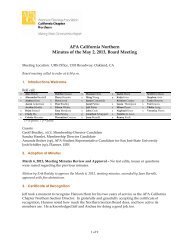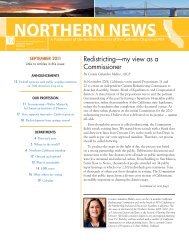Plan-it sustainably - Northern California Section
Plan-it sustainably - Northern California Section
Plan-it sustainably - Northern California Section
You also want an ePaper? Increase the reach of your titles
YUMPU automatically turns print PDFs into web optimized ePapers that Google loves.
Norcal roundup (continued from previous page)Treasure Island cleanup questionedhttp://b<strong>it</strong>.ly/SAWxqz“Recent U.S. Navy explanations for widespread readings of radioactiv<strong>it</strong>y on theformer Treasure Island Naval Station don’t adequately explore the possibil<strong>it</strong>ythat the base might have been dusted w<strong>it</strong>h radioactive ash, soaked w<strong>it</strong>hradioactive sewage, and contaminated by radioactive garbage, <strong>California</strong> healthregulators said on October 5. The response addressed an Aug. 6 draft reportby the Navy, which was aimed at assuaging concerns about the base’s historyof radioactive material. The Navy’s report is part of the process of turning themil<strong>it</strong>ary land over to the c<strong>it</strong>y of San Francisco, which has approved constructionof 8,000 homes there. The August draft included the Navy’s acknowledgementthat the base’s radiation history was more widespread than previouslyreported. But the Navy also sought to assure state and c<strong>it</strong>y officials that aradioactive cleanup was well in hand, and that the base should be ready forpreliminary development some time in 2013. However, the <strong>California</strong>Department of Public Health suggested today in <strong>it</strong>s response to that draft thatthe mil<strong>it</strong>ary agency might have significant work to do to earn a clean bill ofhealth.” —Matt Sm<strong>it</strong>h, “Navy’s Treasure Island radiation report found wanting,”The Bay C<strong>it</strong>izen, Oct. 5, 2012.Climate change affects crop insurance rateshttp://b<strong>it</strong>.ly/SUyQDz“Alterations in the <strong>California</strong> climate have prompted the insurance industry tostart assessing the potential damage and <strong>it</strong>s financial exposure. The nation’scrop insurance system, a hybrid of private insurers backed by the U.S.Department of Agriculture’s Risk Management Agency, has been paying outsteadily increasing amounts for weather-related damages across the country,according to the Congressional Research Service — from $2.1 billion in 2000to a record-breaking $12.1 billion last year. Although <strong>it</strong>’s difficult to distinguishhow many extreme events would have occurred w<strong>it</strong>hout the atmosphericconcentration of CO 2 , the Risk Management Agency now has identified climatechange as one of the major risk factors for U.S. agriculture. Jeff Yasui, directorof the <strong>California</strong> office of the Risk Management Agency, said one sign of thegrowing stress in wine country is that over the past four years, the numberof wine grape growers who increased their insurance coverage from thebase-level policy — which covers half of all losses — to more substantial,and more expensive, protection increased from 28 percent of all policies to40 percent this year.” —Mark Schapiro, Center for Investigative Reporting,“Higher temperatures bring new struggles in Calif. wine country,”The Bay C<strong>it</strong>izen, Sept. 28, 2012.(continued on next page)<strong>Northern</strong> News 9 November 2012


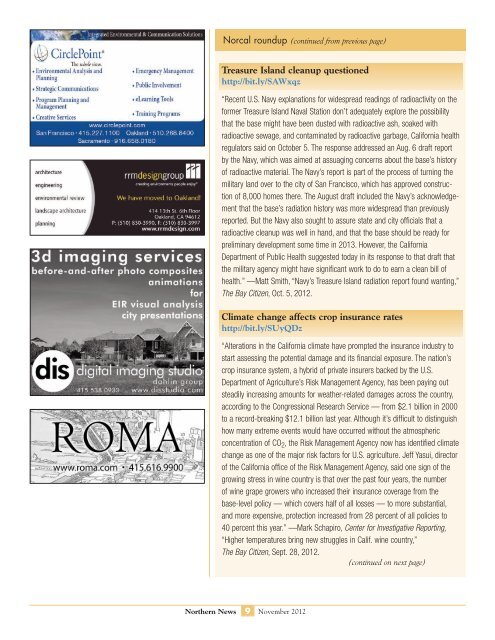
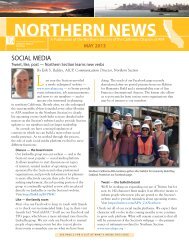
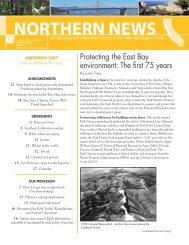
![[NAME OF EVENT] EVALUATION FORM](https://img.yumpu.com/32351925/1/190x245/name-of-event-evaluation-form.jpg?quality=85)
